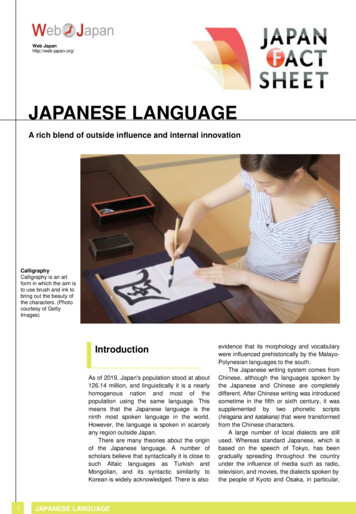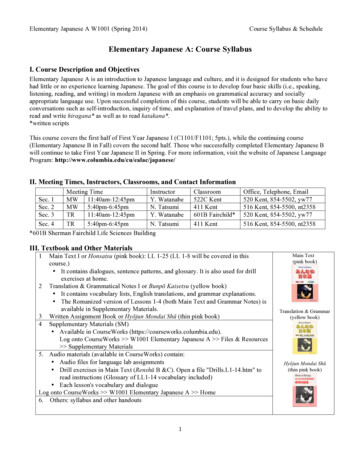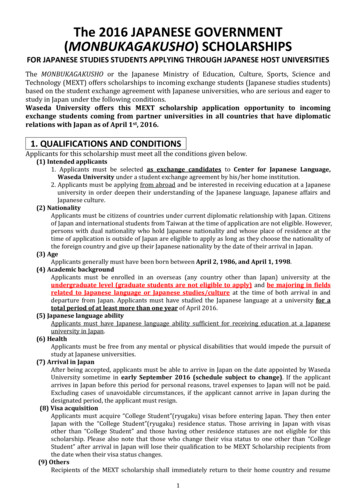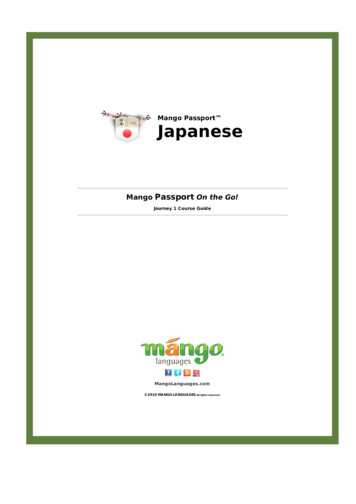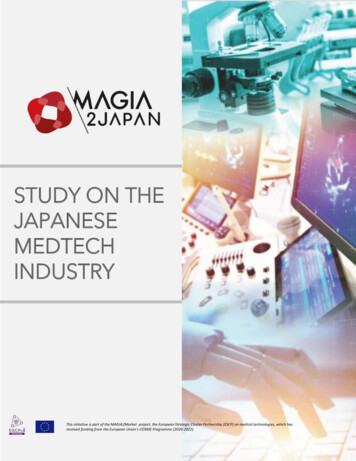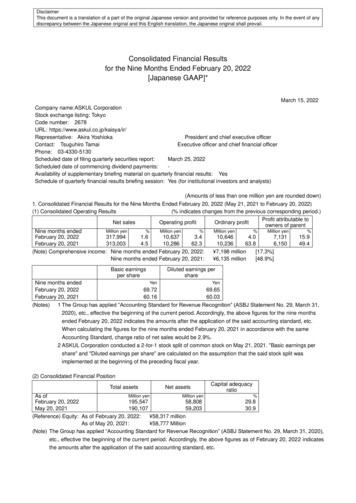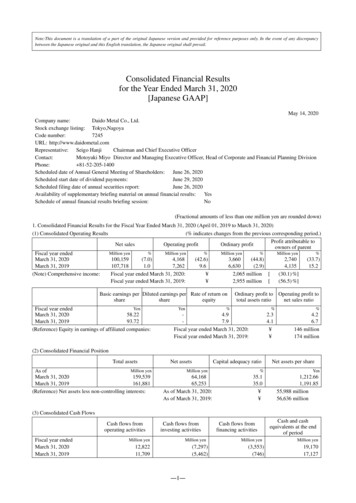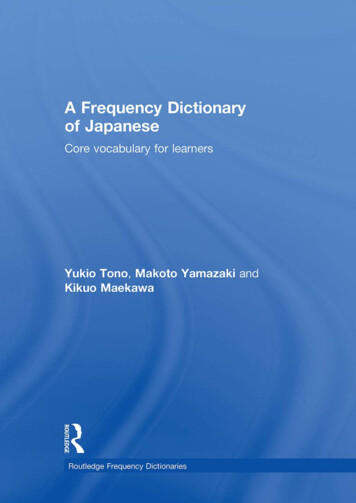
Transcription
Church and State in Japanese-Occupied TaiwanJoel S. Fetzer* and J. Christopher Soper**ABSTRACTWhen an authoritarian government conquers an already colonized territoryand attempts to subjugate its people, how do local Christians respond to suchregime change? Conversely, how do the new imperial masters treat the religion ofexpatriate and indigenous Christian converts? In this paper, we examine thesequestions for Taiwan during the Japanese occupation from 1895 to 1945.Following the lead of Anthony Gill, the essay tests rational-choice theory abouthow the presence or absence of political and religious competition affected theJapanese occupiers’ treatment of Christianity. Next, the paper explores theattitudes of Taiwanese and expatriate Christians toward the new occupiers. Did*Joel Fetzer is Professor of Political Science at Pepperdine University in Malibu, CA. His majorareas of interest and publication are migration politics and religion and politics in East Asia and WesternEurope. The authors are grateful to Pepperdine University for research funding, to Payson Library’sMelissa Pichette for many difficult interlibrary loans, to Matthew R. Jones and Sheng-pinn Wu for helptranslating Japanese-language texts, to Rieko Suganami Evans for providing valuable information about herfather, and to John M. Carroll for advice on historical statistics from Hong Kong.**Chris Soper is Distinguished Professor of Political Science at Pepperdine University. He is theco-author (with Joel Fetzer) of Confucianism, Democratization, and Human Rights in Taiwan, Religion andNationalism in Global Perspective, and (with Kevin R. den Dulk and Stephen V. Monsma) of TheChallenge of Pluralism: Church and State in Six Democracies.
2they perceive the Japanese as potential allies who might open up newopportunities for evangelization of the island’s population or as dislikedforeigners whose actions might repel potential converts?Keywords: Hong Kong, World War II, Japan, Christians, church-state relationsI.INTRODUCTIONWhen a colonizing power acquires new territory, how do local Christians respondto this new political reality? Conversely, how does the new regime treat Christianminorities? In this article, we examine these questions for Taiwan during the Japaneseoccupation from 1895 to 1945. Part of a larger project on the history of church-staterelations in Taiwan and Hong Kong, this essay explores how the apparent absence ofpolitical and religious competition led the Japanese occupiers to treat Christianity withbenign neglect. Similarly, Taiwanese and expatriate Christians largely acquiesced inJapanese rule because they saw it as an improvement over Qing dominance and as part ofa larger, beneficial modernization project.Theoretically, our project tests the economic approach to religion-stateinteractions in an understudied cultural, political, and social setting: East Asia. AnthonyGill’s two pioneering works1 applying rational-choice models to religion and politicshave together focused on the Americas and Eastern Europe rather than Asia or Africa. A1Anthony Gill, Rendering Unto Caesar: The Catholic Church and the State in Latin America(Chicago: University of Chicago Press, 1998); Anthony Gill, The Political Origins of Religious Liberty(Cambridge: Cambridge University Press, 2008).
3couple of later scholars have adopted this perspective when analyzing China, 2 yet eventhe PRC deserves much more academic attention. And no one appears to have used selfinterest to explain church-state relations in East Asia over centuries of Christian presencein the region. 3 Our research thus contributes to the political-science, religious-studies, andhistorical literatures by using this viewpoint for the culturally Chinese island of Taiwansince the arrival of Christianity. Theoretically, the small group of Christians in Taiwanfaced considerable challenges harmonizing their nascent Taiwanese identity with their“foreign” faith. However, as the vast major of Taiwanese Christians originated in thelowest social classes, they hardly constituted a vanguard of opposition to colonial rule.And Western missionaries living in Taiwan often found it easier to reconcile (at least intheir own minds) Christianity with the political aims of Japanese authorities.II.THEORIES OF CHURCH-STATE RELATIONSAccording to Anthony Gill’s rational-choice theory of religious liberty, 4 governmentsprimarily treat religious minorities as well as devotees of the dominant religion in a waythat will strengthen the rulers’ grip on political power and maximize tax revenues and2Yang Fenggang, “The Red, Black, and Gray Markets of Religion in China,” SociologicalQuarterly 47, no. 1 (2006): 93-122; Xie Xiaheng, “Toward an Understanding of the Prosperity ofProtestantism in Contemporary China,” Ph.D. dissertation (Waco, TX: Baylor University, 2011).3Samuel H. Moffett, A History of Christianity in Asia: Beginnings to 1500 (San Francisco:Harper, 1992); Samuel H. Moffett, A History of Christianity in Asia: 1500 to 1900 (Maryknoll, NY: Orbis,1998).4Gill, The Political Origins of Religious Liberty, pp. 26-59.
4national economic prosperity. 5 In contrast to advocates of secularization theory, he claimsthat states restrict or “regulate the religious marketplace” based on the self-interest of thepolitical leaders, not because society is inexorably becoming less religious. Whenrepressing a religious minority poses more “opportunity costs” than benefits among thesethree criteria, governments will tend to allow freedom of conscience.Conversely, if one looks at how a religious group decides to interact with thestate, one key sociological theory belongs to Max Weber. 6 In his terms, a religion mayplay a “prophetic” or “priestly” role. In the first, a church or other religious entityopposes and criticizes the state for its deviations from justice and appeals to thegovernment to return to God’s laws. In the second, clergy give religiously based adviceand comfort to the king or other political leaders, support the government’s policies, atleast in public, and try to get the masses to obey the state by convincing them that God ison the side of the status quo.Although Weber thoroughly describes believers’ two principal approaches to thegovernment, he does not explicate in detail why groups follow one pattern or another(other than pointing to believers’ socio-economic background and fundamentaltheological beliefs). This article therefore turns once again to Gill’s economic model 7 to5This theoretical section draws upon our previous work in Joel S. Fetzer and J. Christoper Soper,“Church and State in Spanish Formosa,” Review of Religion and Chinese Society 1, no. 2 (2014): 236-248.6Max Weber, Sociology of Religion (Boston: Beacon Press, 1963 [1922]); Max Weber, AncientJudaism (Glencoe, IL: Free Press, 1952 [1921]).7Gill, Rendering Unto Caesar, pp. 47-78.
5explain why a church opts to oppose or support the political status quo. 8 Based largely onTwentieth-Century Latin American cases, his first major work argued that nationalCatholic churches adopted a pro- or anti-government policy based on which wouldmaximize their support from the largely poor populace. Before they faced competitionfrom socialists, spiritists, or evangelical Protestants working among the economicallymarginalized, in contrast, the Catholic hierarchy had been content to ally withauthoritarian leaders and their upper-class backers. In a broader context, then, Gill’stheory suggests that a religious group would support or oppose the political authoritiesbased on which option will maximize its number of adherents and amount of resources.Money and other “goodies” from the government are nice, he suggest. But a rationalgroup of believers will not seek such political capital at the cost of popular rejection oftheir religion—at least when ideological competitors are also seeking converts among thesame people.Applied to Taiwan during Japanese occupation, Gill’s first theory implies that theJapanese government would be wary of provoking widespread, active resistant to theirrule and thereby undermining relative political stability and economic development. Any8Although this essay focusses on the political quiescence of Taiwanese missionaries and theirrelative lack of interest in political activism, a possible alternative theory for Christians’ political behavioris Woodberry’s claim that evangelical missionaries fostered democratization by teaching indigenousChristians skills useful for forming a civil society opposed to authoritarianism: Robert Woodberry, “TheMissionary Roots of Liberal Democracy” American Political Science Review 106, no. 2 (2012): 244-274.Indeed, the case for Woodberry’s assertion will become even stronger after World War II, when TaiwanesePresbyterians and even some foreign missionaries spearheaded the democratization and later independencemovements.
6particularly anti-Japanese Christian leaders might be disposed of, but such very smallminority religion should remain more or less unmolested. Moreover, given the modestorgins of most Taiwanese Christians, the Japanese might have even concluded that it wastheir self-interest to promote a religion whose followers posed not political threat to theregime. If Gills’ state-related interpretation is false, however, one would expect theJapanese government to impose State Shinto on the entire population regardless ofpolitical and economic consequences.For the church in Japanese-occupied Taiwan, rational-choice theory would positthat Christian leaders would try gain favor with the colonial authorities who hadresources that could be useful for their religious work. This logic would, of course, onlyhold where the majority of the general population either favors or is neutral toward thegovernment. Before the beginning of the hostilities that led to World War II, thiscondition generally prevailed.III.CHRISTIANS IN JAPANESE-OCCUPIED TAIWANThe Japanese gained control over Taiwan as a result of the 1895 Treaty of Shimonoseki,which ended the first Sino-Japanese War. Under the terms of this treaty, Qing Chinaceded full sovereignty of Taiwan to Japan, thus ending two centuries of at least partialrule of the island.Japanese colonization posed an interesting dilemma for the largely westernChristian missionaries on Ilha Formosa. On the one hand, these missionaries identifiedwith and ministered to local Taiwanese, who might have been expected to oppose theinvasion of a foreign occupying force. However, Christian missionaries had experienced
7limited numerical success among the native population, and the foreign believersattributed this outcome both to the “backward” attitudes of the local residents and toopposition from the local Confucian bureaucratic elite. Canadian George Leslie MacKay,the most famous Christian missionary in Taiwanese history, accused Qing functionariesof “universal official corruption,” “unmitigated lying, cheating, and oppression,” and“violence and injustice inflicted upon Christians in North Formosa.” 9 Given this officialhostility to Christianity, it is not surprising that another prominent missionary, theEnglish Presbyterian Thomas Barclay, concluded about the impending Japaneseoccupation that “In the meantime, there seems to be some advantages to be hoped for.The destruction of the Mandarinate and perhaps still more than that of the literary class asa body, involving the discrediting of Confucianism, will remove more obstacles out ofour way.”10Moreover, the converts that missionaries had won over were not part of the localruling class but instead concentrated in the lowest economic levels of Taiwanese society.Missionary accounts, moreover, suggests that their proselytizing was particularlysuccessful among indigenous groups living in the western, “plains” region of Taiwan. 11Ironically, then, most foreign Christian leaders and their Taiwanese converts were eitherindifferent or even sympathetic to Japanese control of Formosa. 12 As noted above, theTaiwanese Christian population was sparse; at the time of the Treaty’s signing, Taiwanwas home to an estimated 2,000 Roman Catholics, 2,500 English Presbyterians (largely9George Leslie MacKay, From Far Formosa: The Island, its People and Missions (New York:Fleming H. Revell Co., 1895), pp. 105, 112 & [ ].10William J. Richardson, Christianity in Taiwan Under Japanese Rule, 1895-1945, dissertation(New York: St. John’s University, 1971), p. 42.11MacKay, From Far Formosa, p. 103; Ion, The Cross and the Rising Sun, pp. 78-79.12A. Hamish Ion, The Cross and the Rising Sun: The Canadian Protestant Missionary Movementin the Japanese Empire, 1872-1931. (Waterloo, Ontario, Canada: Wilfrid Laurier University Press, 1990),p. 81.
8in the south), and 2,600 Canadian Presbyterians (mainly in the north). 13 Given an islandwide population of just over 3 million in 1905, 14 the Christian proportion of allTaiwanese was minuscule. As a rational-choice interpretation of religious mobilizationwould predict, therefore, Taiwanese Christians had no incentive to defend the Qingpolitical and social system that deeply disadvantaged them.During a brief interlude between the formal acquisition of Taiwan by the Japaneseand the arrival of their troops on the island, Taiwanese loyalists established the “TaiwanDemocratic Republic [Taiwan minzhu guo].” This short-lived republic ended, however,once that the Japanese military took over from the Qing authorities. While the transitionto Japanese control was relatively peaceful in the north, Taiwan Republic leader LiuYongfu led violent resistance in the south to the new status quo. 15 Despite this politicalturmoil, Christion on Formosa did not fervently support the Republic and so facedcharges that they were actually Japanese collaborators. In one instance, pro-Republicanactivists killed over a dozen Christians whom they accused of sympathizing with the newcolonial power. While not necessarily actively helping the Japanese conquer the island,Taiwanese Christians were generally optimistic about the results of Japanese rule. In fact.Presbyterian missionaries Thomas Barkley and Duncan Ferguson met with Japaneseforces to negotiate an end to the conflict at the Taiwan Republic capital of Tainan. Theirefforts ensured that the city was spared the devastation that would have resulted from13Richardson, Christianity in Taiwan, pp. 165-166.Republic of China, The Republic of China Yearbook 2009 (Taipei: Government InformationOffice, 2009), p. 37.15Hollington K. Tong, Christianity in Taiwan: A History, 2nd ed. (Taipei: China Post, 1972), pp.53-54.14
9further Japanese bombardment. In recognition of their “contribution,” the missionariesreceived the “Order of the Rising Sun (Fifth Class)” from the Emperor of Japan. 16For a variety of reasons, therefore, Taiwanese missionaries and local Christianslargely sympathized with the Japanese. Taiwanese Christians had been disadvantagedunder the Qing regime, and missionaries saw the Japanese as more likely to permit oreven encourage further evangelization of the island. Finally, the largely westernproselytizers understood their own efforts as “bringing civilization” to a “backwardland,” a project that seemed more compatible with Japanese control because of thatcountry’s pro-western outlook.IV.JAPANESE TREATMENT OF CHRISTIANSOverall, these rosy expectations were fulfilled, at least before the beginning of WorldWar II. Japanese officials generally did show more support for Christianity than had theirManchu predecessors. 17 This new relationship with the regime does not seem to have hurtChristians’ effort to proselytize; in fact, the number of Christians grew dramatically overthe next several decades. Presbyterians grew from 5,100 in 1895 to 31,000 by 1938.Catholic statistics similarly rose from 2,000 to 7,000 over the same period. 18 Taiwanexperienced parallel economic development, educational expansion, and infrastructuremodernization under the Japanese. According to one analysis, the island had the fastestrate of economic growth among all of colonial Asia. 1916Richardson, Christianity in Taiwan, pp. 57-58.A. Hamish Ion, The Cross and the Rising Sun: The British Protestant Missionary Movement inJapan, Korea, and Taiwan, 1865-1945, “Vol. II” (Waterloo, Ontario, Canada: Wilfrid Laurier UniversityPress, 1993), p. 80.18Richardson, Christianity in Taiwan, pp. 165-166.19Anne Booth and Kent Deng, “Japanese Colonialism in Comparative Perspective,” Journal ofWorld History, vol. 28, no. 1 (2017): pp. 61-98.17
10The above is not to suggest that Taiwanese Christians and the new governmentnever came into conflict. Efforts to nipponize, or culturally assimilate Taiwanese, attimes, posed a potential threat to Christians on the island. The most notable examplecentered around schoolchildren’s compulsory attendance and participation in Shintoceremonies at shrines on national holidays and at the beginning and end of each schoolyear. This edict also held for institutions run by Christian missionaries. 20 Because theywere run by foreigners, mission schools appeared suspect in the eyes of some Japaneseofficials. Nevertheless, absence of large-scale opposition to colonial rule meant that theJapanese did not resort to the heavy-handed tactics used in such other colonies as Korea.Instead, the new authorities tried to work with religious leaders to find ways around suchconflicts as the shrine dispute. Negotiations between government officials andPresbyterian representatives, for example, led to a compromise position where missionschools followed the policy in a way that both parties claimed was acceptable. 21 Japaneseofficials assured Christian leaders that the shrines were not religious and that shrinepriests were government officials, not religious authorities. The Presbyterian Churcheventually abandoned its opposition to these ceremonies. 22 The Catholic Church similarlyruled that shrine rites were “purely civil and patriotic and thus did not in any way conflictwith the religious practices of Roman Catholics.” 23Of course, the beginning of World War II marked a turning point in Japanesepolicy in Taiwan and throughout Asia. Some individual Christians who were outspoken20Richardson, Christianity in Taiwan, pp. 170-171; Ion, The Cross and the Rising Sun: TheBritish Protestant Missionary Movement in Japan, Korea, and Taiwan, 1865-1945, p. 243.21Ion, The Cross and the Rising Sun: The British Protestant Missionary Movement in Japan,Korea, and Taiwan, 1865-1945, p. 212.22Richardson, Christianity in Taiwan, p. 176.23Richardson, Christianity in Taiwan, p. 173.
11in their opposition to Japanese treatment of co-religionists or fellow Asians in Korea orChina found themselves in prison for their views. For example, Pastor Kami Yojirō, aJapanese Christian who served in Taiwan from 1918 to 1947 24 and later directed theTaiwan Theological Seminary in Taipei, 25 strenuously objected to the Japanese army’stake-over of Manchuria in 1931. For their troubles, he and a small number of similarlyminded Taiwanese Presbyterian ministers were arrested and interrogated by the Kempei,the Japanese secret police. Even so, the authorities spared Kami’s life, and a number ofother Taiwanese clergy criticized his “subversive actions.” 26 The situation for AboriginalChristians was more dire, however, arguably because they represented both converts to a“foreign,” western religion and the ethnic group that had most strongly resisted Japaneserule. Among the “mountain tribes” of indigenous Taiwanese, for instance, police wereconstantly on the lookout for “suspect” pastors or church leaders. 27 By 1940, conditionsfor all Christians had deteriorated to such an extent that the English Presbyterian Missionin southern Taiwan closed, and virtually all foreign missionaries left the island. Policesupervision of native Christian likewise intensified. Pastors were required to preach onlyin Japanese, and an ethnic Japanese needed to direct any religious schools or hospitals. 28V. CHRISTIANS’ SUPPORT FOR OR OPPOSITION TO JAPANESE OCCUPATION24Lee Chia-song, Yi bai nian lai: shifeng yu fuwu de rensheng (Taipei: Youta jiapu xuehui, 1979),pp. 121-123; available at on/Li,Ksiong.htm (accessedSeptember 17, 2018).25Thoân-tō Pò-kok, The Study of “Den-doo Hoo-koku” Identity of Taiwan Christians duringJapanese Colonial Period, 1937-1945 [in Chinese] (Taipei: Taiwan Normal University, HistoryDepartment, 2017), p. 127.26Otabe Sanpei et al., Kami no kazoku Taihoku Nihon Kirisuto Kyōkai no omoide, vol. II (Tōkyō :Kami Itsuki, 1989), pp. 75-76.27Edward Band, ed., He Brought Them Out: The Story of the Christian Movement among theMount Tribes of Formosa (London: British and Foreign Bible Society, 1956), pp. 5-6.28Ion, The Cross and the Rising Sun: The British Protestant Missionary Movement in Japan,Korea, and Taiwan, 1865-1945, p. 245; Tong, Christianity in Taiwan: A History, p. 76-80.
12Given the relatively benign treatment of Taiwanese Christians before the Second WorldWar and the rapid economic and social modernization on the island, it is hardlysurprising that Christians largely acquiesced in Japanese occupation. As we noted above,the Church grew quickly during this period, suggesting that this alliance with the newrulers did not hinder Christians’ efforts at evangelization. This situation contrastsmarkedly with that in occupied Hong Kong and Korea, where Japanese actions were soloathsome that any appearance of sympathy with the hated occupiers would have damnedChristian proselytizing.As we documented earlier, Christian missionaries helped negotiate a trucebetween the Japanese army and Taiwanese Republicans. In gratitude, the Japaneseawarded them official honors. Shortly thereafter, Taiwanese Christians established closeworking relations with their counterparts in Japan proper. Christians in Taiwan evenfound a sympathetic ear among Japanese elites, some of whom embraced the new faith. 29A few ministers were troubled by worship at Shinto shrines, but given the relativelyfriendly relations already established between Christians and the authorities, localbelievers persuaded themselves that the matter did not represent an insurmountabletheological barrier to cooperation with the government.VI.DISCUSSIONOverall, this examination of Taiwan during Japanese occupation generally confirmsGill’s theory about the roots of religious freedom and Christian opposition to the state.For the Japanese government, the opportunity costs of suppressing Christianity werehigher than any economic or political benefits from doing so. The Christian population in29Tong, pp. 60-61.
13Taiwan was minuscule, and those few Christian leaders that did live on the island tendedto prefer the Japanese to the Qing.From the local Christian perspective, amicable relations with the Japaneseauthorities was both rational and beneficial. Christian leaders saw Japanese occupationthrough the prism of the advantages of “western civilization.” An island that manymissionaries saw as “backward” would in their view benefit from colonization by a more“modern” country. For this reason, they were cautiously optimistic about Japanese rule.Since the Japanese in Taiwan were not hostile to Christianity before World War II,Christians perceived the regime as relatively benign and largely played a priestly ratherthan prophetic role on the island. Further reinforcing this perception were the rapideconomic modernization of Formosa and the dramatic growth of churches in the earlydecades of Japanese colonization. Given these conditions, Christians did not stand to losepotential converts by allying with the new government.This situation contrasts dramatically with the plight of Christians in both HongKong and Korea. 30 In those areas, the Japanese occupiers acted much more brutally. Thevast majority residents of both Hong Kong and Korea loathed the Japanese occupiers.Any friends of the Japanese would therefore have immediately become the enemies ofordinary Hong Kongers or Koreans, and devotees of traditional Asian religions wouldhave been much less likely to convert to Christianity. In Christians’ minds, a governmentcallously causing the deaths of thousands of ordinary citizens was not likely ever to “winthe hearts and minds” of the people. Another important contrast with Taiwan was that thepopulation of both Korea and Hong Kong identified much more with a non-JapaneseChengpang Lee, “State Building and Religion: Explaining the Diverged Path of ReligiousChange in Taiwan and South Korea, 1950-1980,” American Journal of Sociology, vol. 123, issue 2 (2017),pp. 465-509.30
14nation than did ordinary Taiwanese. The development of both Korean and Chinesenationalism affect the churches in these regions, thus problematizing any alliancebetween Christians and the Japanese. The relative absence of specifically Taiwanesenationalism at this juncture meant that churches did not have to consider the nationalistsentiments of potential followers. Ironically, Taiwanese Presbyterian leaders would laterally themselves with nascent Taiwanese nationalism as it developed during and followingdemocratization.
5 This theoretical section draws upon our previous work in Joel S. Fetzer and J. Christoper Soper, "Church and State in Spanish Formosa," Review of Religion and Chinese Society 1, no. 2 (2014): 236-248. 6 Max Weber, Sociology of Religion (Boston: Beacon Press, 1963 [1922]); Max Weber, Ancient Judaism (Glencoe, IL: Free Press, 1952 [1921]).
